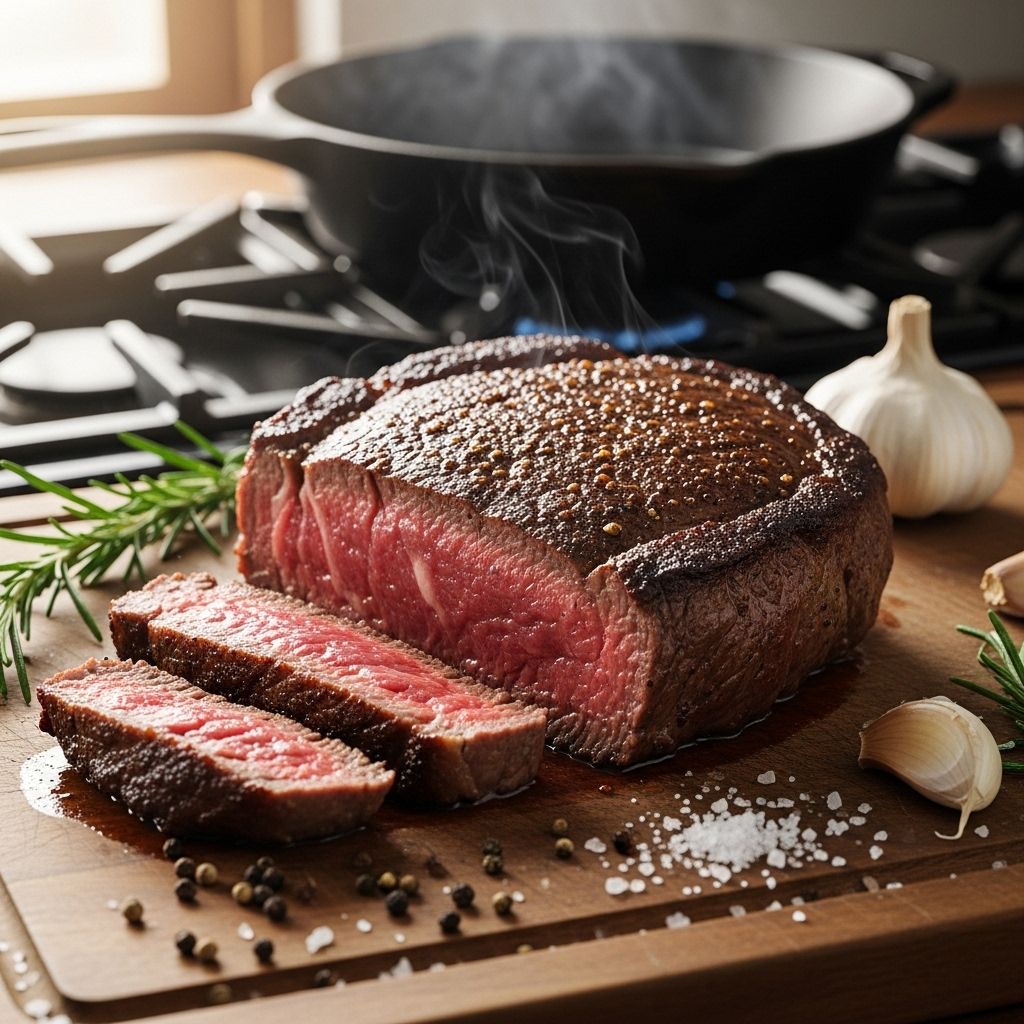The Science of Perfect Pan-Seared Steak: Step-by-Step Guide
Harnessing precise heat and technique elevates every cut with deep, savory flavor and juiciness.

The Science of Perfect Pan-Seared Steak
If you’ve ever wondered how to achieve a steakhouse-quality crust and juicy, tender interior in your own kitchen, you’re not alone. Perfectly pan-seared steak is a pinnacle of home cooking mastery—a simple dish made exceptional through precise technique, an understanding of culinary science, and a few insider tricks. This comprehensive guide unpacks all the steps, pitfalls, and professional secrets you need for flawless steak every time.
Why Pan-Searing Works: The Science Behind the Sear
The heart of great steak is the seared crust. This irresistible brown layer forms thanks to the Maillard reaction—a series of chemical changes that happen when amino acids and sugars on the surface of meat react over high heat. This process creates deep, complex flavors and that signature golden-brown, slightly crispy exterior that steak lovers crave. The challenge: achieving this crust without overcooking the inside.
- Maillard Reaction: Starts around 285°F (140°C) and speeds up at higher temperatures.
- Ideal Steak Crust: Requires dry surface, high heat, and good contact between meat and pan.
- Juicy Interior: Achieved by balancing searing and gentle doneness control.
Choosing the Best Steak for Pan-Searing
Not every cut is equally suited for a pan. For best results, select steaks with these attributes:
- Thickness: 1.5 to 2 inches thick is optimal. Thinner steaks can easily overcook before a crust forms.
- Marbling: Moderate to well-marbled cuts (visible small flecks of fat) deliver more flavor and juiciness.
- Prime Cuts: Ribeye, striploin (New York strip), and filet mignon are classic choices. Sirloin and hanger steak also work well.
Preparation: Drying and Seasoning the Steak
Excellent steak starts long before it hits the hot pan. Careful prep makes all the difference:
- Dry the Surface: Pat the steak dry with paper towels to reduce surface moisture. For extra dryness (and better sear), place uncovered on a rack in the refrigerator for 4–24 hours.
- Generous Seasoning: Liberally sprinkle both sides with kosher salt. For classic flavor, add cracked black pepper just before cooking.
- Bring to Room Temp: Let the steak sit at room temperature for 30–45 minutes before cooking, ensuring even internal cooking.
The Tools: What You Need for Success
Investing in the right equipment is crucial for steak perfection. Here are the essentials:
- Heavy Skillet: Cast iron or stainless steel pans provide superior heat retention and even browning.
- Instant-Read Thermometer: Essential for monitoring doneness accurately.
- Tongs: For easy maneuvering and edge-searing.
- Wire Rack & Baking Sheet: Handy if you opt for finishing or pre-cooking in the oven.
The Classic Pan-Sear Method: Step-by-Step
The basic technique for restaurant-quality steak is both simple and effective. Follow these steps for perfect results:
- Preheat the Pan: Set your skillet over high heat and let it get very hot, typically for 3–5 minutes. The pan must be almost smoking for an ideal sear.
- Add Oil: Add a high smoke-point oil (such as canola or grapeseed). Swirl to coat the surface lightly.
- Sear the Steak: Place steak down and press gently to maximize contact. Do not move for the first 1-2 minutes. Flip with tongs and repeat. Sear the edges briefly.
- Lower the Heat (Optional): For thick steaks, lower heat to medium after the initial sear to finish cooking more gently.
- Monitor Temperature: Insert an instant-read thermometer into the center (from the side for accuracy):
Doneness Pull at Temp (°F/°C) Rare 120-125°F / 49-52°C Medium-Rare 125-130°F / 52-54°C Medium 135-140°F / 57-60°C Medium-Well 145°F / 63°C - Baste with Butter & Aromatics (Optional): In the last minute, add a couple tablespoons butter, smashed garlic, and fresh thyme. Tilt the pan and spoon foaming butter over the steak.
- Rest, Then Serve: Allow steak to rest on a rack or cutting board for 5 minutes before slicing. This step helps redistribute juices for maximum tenderness.
The Reverse Sear Technique: For Thick Steaks
For cuts thicker than 1.5 inches, a reverse sear produces unmatched consistency from edge to edge and an equally impressive crust. Here’s how:
- Dry and Season: As with the classic method, start with a dry, salted steak.
- Slow-Roast: Place steak on a wire rack over a baking sheet. Cook in a low oven (200–275°F / 93–135°C) until it’s about 10–15°F (6–8°C) below your target temperature (see doneness chart above).
- Rest Briefly: Allow to rest while you heat the skillet.
- Sear: Finish in a screaming hot pan with a small amount of oil, flipping every 30–45 seconds. Sear the edges to render fat and create a uniform crust.
- Serve Immediately: Unlike the classic sear, reverse-seared steaks require no extended resting period and can be served hot from the pan.
Essential Tips for Perfect Results
- Do Not Overcrowd the Pan: Cook one steak at a time or ensure plenty of space. Crowding leads to steaming, not searing.
- Flip Often for Thick Steaks: Frequent flipping evens cooking and encourages a more even crust.
- Season Boldly: Salt is your friend. Underseasoned steak will taste bland.
- No Need to Rest After Reverse Sear: The gentle oven phase means juices are already settled.
- Always Sear the Edges: Especially important for fattier cuts like ribeye.
Troubleshooting: Common Pan-Searing Mistakes
- Pale Crust: Surface too wet, pan not hot enough, or overcrowding. Ensure steak is dry, preheat pan well, and cook only one or two at a time.
- Gray Banding: Overcooking the surface due to excessive heat for too long. Consider reverse searing for a more even doneness.
- Smoking/Burning: Using butter alone from the start will scorch. Start with oil, add butter late in cooking for flavor and aroma.
- Dry Steak: Internal temperature exceeded. Use a thermometer and pull the steak early, allowing for “carryover” cooking as it rests.
The Role of Butter-Basting: Boosting Flavor
Butter-basting is more than just a finishing touch. By adding butter, aromatics like garlic and thyme, and rapidly spooning the hot fat over the steak in the final moments of cooking, you amplify richness and create deeper flavors. This also helps brown the steak’s surface faster without overcooking the interior.
- Start with oil for the initial sear— oils handle the high heat better.
- Add butter, garlic, and thyme during the last minute or two.
- Tilt the pan and continuously spoon the melted, aromatic butter over the top—a method called “arroser.”
Sliced and Served: Maximizing Tenderness and Juiciness
Proper resting allows steak fibers to relax and juices to redistribute, reducing runoff when sliced. Here’s how to finish professionally:
- Always rest after the classic sear: 5–10 minutes for thicker cuts.
- Slice against the grain: This shortens muscle fibers and enhances tenderness.
- Add finishing salt and cracked pepper: Just before serving for texture and fresh pop.
Frequently Asked Questions (FAQs)
Q: Can I get a great sear without cast iron?
A: Yes, heavy-bottomed stainless steel pans also deliver an excellent crust. Avoid nonstick pans as they can’t handle high heat as well or create the same browning.
Q: How do I avoid flare-ups and excessive smoke?
A: Use a neutral oil with a high smoke point (like canola), dry the steak thoroughly, and run a vent or open windows. Don’t use butter until near the end.
Q: Is resting always necessary?
A: Yes for classic searing, but the reverse sear technique’s gentle oven phase means you can serve immediately with no loss of juiciness.
Q: How do I know when my steak is done?
A: Use an instant-read thermometer for precise results. Visual cues aren’t reliable, especially in thick cuts. Refer to the temperature chart above for your preferred doneness.
Q: Can I season my steak in advance?
A: Absolutely. Salting 40 minutes to overnight ahead draws out moisture, which is then reabsorbed, helping build deeper flavor and better surface drying for improved browning.
Final Table: Quick Reference for Pan-Searing Steak
| Step | Tip |
|---|---|
| Choose the steak | 1.5–2 inches thick, well-marbled cuts |
| Prep | Dry surface, salt generously, bring to room temp |
| Pan & Oil | Cast iron or steel; high smoke point oil |
| Searing | Hot pan, do not move steak for first 2 minutes |
| Butter Baste | Add late, spoon over steak with aromatics |
| Checking Temp | Thermometer in center, check chart |
| Rest & Slice | Rest 5–10 min (classic); slice against grain |
Conclusion
Great pan-seared steak combines the best of culinary tradition and modern technique. By controlling surface moisture, maximizing heat, and understanding the science of browning and resting, you can transform even the simplest cut into a memorable meal. Whether you prefer a blazing-hot classic sear or the precise reverse-sear approach, these techniques will elevate your home-cooked steaks to steakhouse heights. Happy cooking and enjoy every juicy bite!
References
Read full bio of Anjali Sayee












